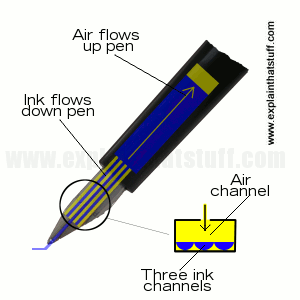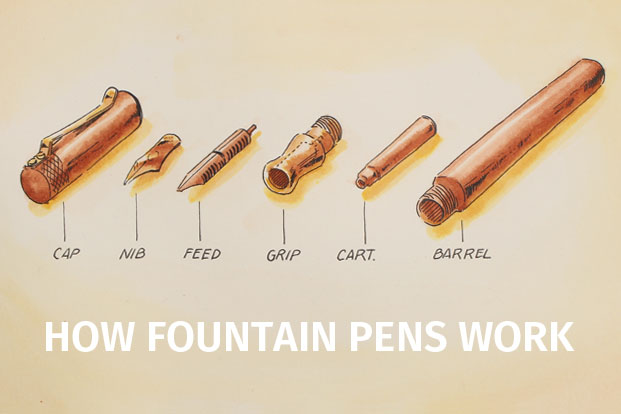Today, everybody can afford a fountain pen. but long back, only the rich can buy a fountain pen. Then, people used what is called a 'dip pen' or a quill. A bird's feather was taken. It was sharpened at one end. People dipped it in a ink bottle and wrote with it. You know, frequent dipping was required.
Fountain pen was invented. It has a surprising science behind it. First, it has so many parts. reservoir, nib, feed or collector, cap, clip, barrel miniature piston mechanism or ink cartridge and even a breathing hole.
Take an ink bottle. Open its wide mouth. Try to write with it. We know, the ink will uncontrollably flow out. We will only create a nasty mess and will not write a word.
We are aiming for the controlled leak in the pen. Hence the design of the pen is very important.
Now cover the ink bottle with its cap and make a thin hole with a pin. Turn the bottle upside down. Ink will not fall through the hole because of upward air pressure. For the same reason ink is not flowing out from the open pen. Now make another hole in the cap of the bottle. Hold the bottle slantingly and try to write with it on a paper. Air will flow into the bottle through one hole and the ink will ooze out through another hole. Now that we have provided a free path to the air, you will be able to scribble something with the bottle. A 'rough pen' is born.
In the real pen; a three narrow tubes are running from the ink tank (reservoir) to the collector or feed. The collector is a plastic part which has fins or grooves. A tapered metal nib is attached on the collector. There is a small breathing hole at the center of the nib. A narrow slit is running through the nib from the breathing hole to the end point of the nib. Yet another tube connects the collector and the reservoir for the air flow.
The ink flows from the tank; through thin tubes; to the collector or feed; run through the slit in the nib and finally to the end point of the nib. Mean while air pass through the breathing hole and fills up the emptying reservoir. Here the ink flow is mainly due to "gravity" and "capillary action".
Take a piece of cotton cloth. Touch it with a pen's nib. The clothe sucks up the ink due to adhesive force. The ink spread on the cloth quickly. Try to write with the pen on a plastic or metal surface. You know, it is impossible. Since there is no adhesive force between the ink and plastic surface.
Draw a line on a paper. There is exactly correct adhesive force between the ink and the paper. Paper pulls up the ink molecules.
Today, we use cheap gel filled plastic ball pen. It is compact and portable. But the writing cannot match a fountain pen.
Today we mainly use, SMS, What's app, e mails, voice calls and video calls. Everything is type written. Will the hand writing go obsolete and vanish. I am positive. Painting still survives in the age of DSLR photography. So will the handwriting and the fountain pen.
See, how much thoughts and innovation had gone into making of a simple pen. Every artifacts and devices was created with great hard work and overcoming many failures. We have something to learn from each artifact.
FOOT NOTE: Because of handwriting and pen, our signature served as ID for a long time. Today we use bio metrics such as finger print, Iris of eye, face etc.
--------------------------------------------------------------------------------------------------


